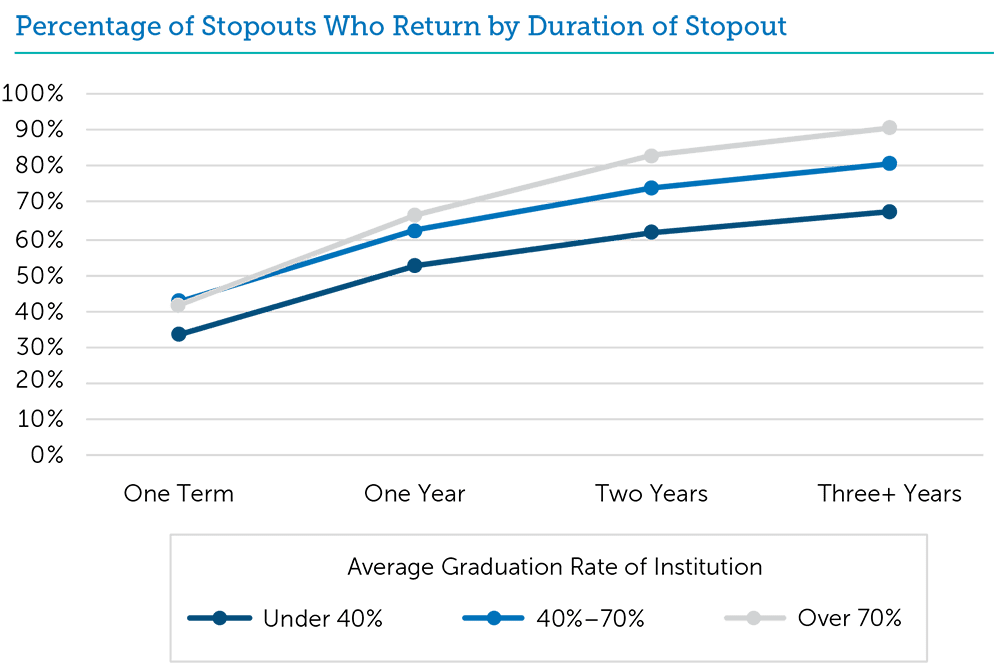What data shows about student stopout trends
Students stop out every year, but the pandemic has forced students who left college and found themselves with unstable employment to reconsider their education goals. Similarly, there are students who might have persisted who have now left our campuses due to the pandemic. To meet the challenge presented by either of these circumstances, it is time for colleges to re-evaluate their strategy for finding, re-enrolling, and supporting their stopouts.
What is a stopout?
A stopout is a student who withdraws from enrollment at a college or university for a period of time.
A popular session at last year’s annual student success summit, CONNECTED, presented our latest research on student stopouts. Colleges across the country are eager to tackle enrollment declines by encouraging students who previously left college to return. These schools want to better understand what it takes to incentivize student stopouts to re-enroll and how to support their diverse needs once they do. In short, colleges want to deliver on their unfulfilled promise to those students who stopped out.
To better understand the experience of stopping out, we followed a cohort of college students from 150+ EAB partners across terms to see what percentage would return to school (either to attend additional classes or to graduate). This allowed for insight into students who maintained steady enrollment, in addition to those who stopped out but returned in a future term. To look for different trends across institution type, we then divided the data by institutional graduation rate.
We wanted to know: Is there a point in time that colleges should focus their outreach efforts to stopouts, and does it vary by school-type?
3 insights from our analysis of student stopouts
1. Some students remain unaccounted for
Regardless of your school’s graduation rate, at the end of any given term, some students who attended the term before are now unaccounted for. These students didn’t graduate and they didn’t come back for classes. These are your student stopouts—and they exist at every college or university.
2. Stopouts are most likely to return within a year—and more than half do
The graph below summarizes our findings. Following students from any given term, you can see how many return the next term and how the percentage of accounted for students from that given term return as time goes on.

For example, at colleges with graduation rates over 70% (the top gray line) and those with graduation rates between 40% and 70% (the bright blue line), 42% will return after just one term. After one year, that total increases to over 60% for these institutions.
Similarly, schools with graduation rates under 40% see 33% of their stopped out students return after one term and 53% return after one year.
We were pleasantly surprised to see that more than half of all students who stopped out would return within a year. This is likely because of the effort so many colleges put into re-enrollment campaigns, but it’s also a great indicator that those efforts are paying off!
3. Trends remain the same regardless of school type
In addition to the prevalence of student stopouts across institutions, we were impressed that the rate of student return is fairly similar in each group, as indicated by the trendlines in our data mirroring each other so closely. The biggest difference is in the percentage of students who leave college at all, failing to persist consistently term-over-term. This highlights the importance of consistent enrollment on your overall graduation rate.
65 Community College Advising Campaign Ideas
In my interviews with college administrators for my research about stopouts, many admitted they had no strategy for trying to re-recruit students who had left. But I also spoke with some who had robust systems in place to find and support students who didn’t complete their degree during their first enrollment. These efforts are promising—and not only as a strategy for offsetting the looming enrollment crisis. In our analysis, we found that students who re-enrolled after stopping out were more likely to graduate than not, even if they had been out for multiple years.
Rather than leaving our stopped-out students with debt from a credential they never earned, let’s show them that it’s not too late to achieve the goal they set out to achieve with us. We are better prepared to support today’s students than ever before, so now is the time to reach out to those we have failed in the past and support them through graduation. It’s the right answer for students, for our institutions, and for our communities.
More Blogs

4 lessons about the “make-or-break year”

Four ways community colleges can improve career readiness
